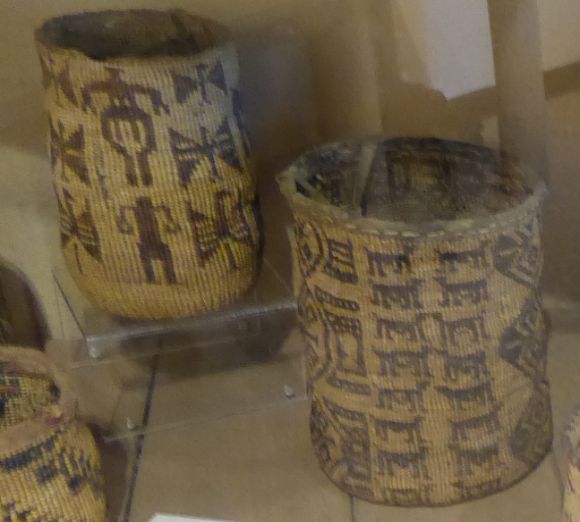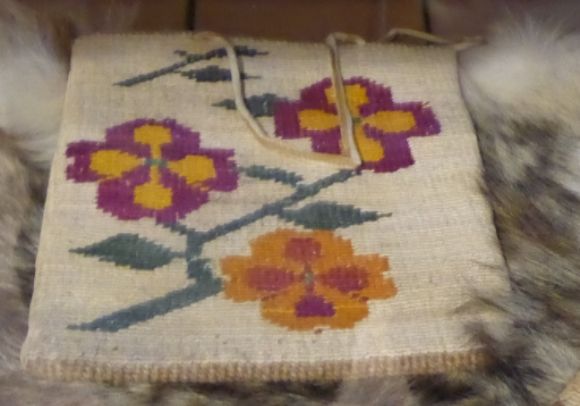Today, the Columbia River marks the boundary between Oregon and Washington. The river was named for the ship Columbia Rediviva whose captain, John Gray, sailed into the area in 1792. Gray was the first of many Euroamerican fur traders who would invade the area over the next half century.
American Indians had lived along the Columbia River for more than 10,000 years when the fur traders first made their appearance. The many different Indian nations and villages along the river were no strangers to the idea of trading as the river functioned as a kind of super-highway, linking the Indian nations of the Pacific coast with those of the Columbia Plateau, Great Basin, and even the Great Plains.
Prior to the arrival of the Europeans, baskets were an important trade item for the Columbia River Indian nations. As Europeans became more numerous in the region, they also traded for baskets. Over time, the basket makers began making baskets which were designed specifically for the non-Indian market.
In an essay in Woven History: Native American Basketry, Mary Dodds Schlick writes:
“The Native people of the Columbia Plateau are rich in basketmaking tradition. For thousands of years their ancestors have used the roots, bark and grasses of the region to fashion containers for all their needs. Today a small number of descendants of these basketmakers continue this ancient heritage, an art form known worldwide for fine craftsmanship, variety in design, and beauty.”
In his book People of the River: Native Arts of the Oregon Territory , Bill Mercer writes:
“Basketry is an art form that reached great heights of creative expression among the people of the Columbia River region. Although baskets served primarily functional purposes, they were nevertheless constructed with great care and decorated with sophisticated designs that lent them an aesthetic status beyond mere utilitarian objects.”
With regard to the tradition of making baskets, Bill Mercer reports:
“Numerous and time-consuming steps went into the making of a basket, and the art of basketry was passed down from one generation to the next, with young women learning from a more experienced female relative, such as a mother, grandmother or aunt.”
Most of the basketmakers were women, but many young boys also learned this skill. In her book Columbia River Basketry: Gift of the Ancestors, Gift of the Earth, Mary Dodds Schlick reports:
“Most basketmaking, that essential industry, was carried out in wintertime when food-gathering was over for the year and families could settle into their winter homes.”
Gather materials for making baskets was usually a group activity carried out by family and friends. In her entry on basketry in the Encyclopedia of North American Indians, Sherrie Smith-Ferri reports:
“Weavers collected limited amounts, taking care to leave enough behind to ensure plant regeneration for future harvests. People always gave thanks for what was taken; they said prayers, sang songs, or left small gifts of food or tobacco.”
Sherrie Smith-Ferri also reports:
“Basket makers utilized a number of horticultural methods, including pruning, controlled burning, soil cultivation, and weeding, to optimize the production of desirable plant features.”
The Columbia Gorge Discovery Center in The Dalles, Oregon has displays of some Columbia River basketry.
Native American Baskets












 Shown above is a cedar bark basket.
Shown above is a cedar bark basket.
Klickitat Coiled Cedar Baskets
According to the Museum display:
“The Klickitat people lived north of the Columbia River on the east side of the Cascade Mountain Range. They are famous for their coiled baskets. Their baskets were well utilized as an exchange medium. Native Americans came from long distances to trade for Klickitat baskets.”
These baskets were made from cedar roots and bear grass.





Indians 101
Indians 101 is a series exploring American Indian arts, cultures, biographies, histories, and current concerns. More about American Indian basketry from this series:
Indians 101: Oregon Coast Indian Baskets (Photo Diary)
Indians 101: Aleut Basketry (Photo Diary)
Indians 101: California Indian Baskets in the Maryhill Museum (Photo Diary)
Indians 101: Arctic Baskets (Photo Diary)
Indians 101: Klikitat Baskets (Photo Diary)
Indians 101: Pomo Indian Baskets (Photo Diary)
Indians 101: Southwestern Baskets in the Maryhill Museum (Photo Diary)
Indians 101: Mission Indian Baskets in the Maryhill Museum (Photo Diary)
Indians 101: Plateau Indian Baskets (Photo Diary)


